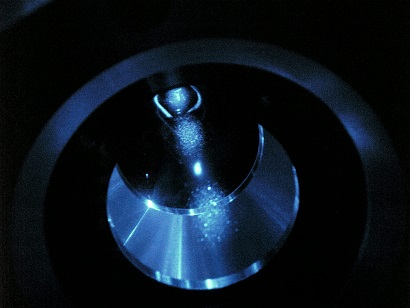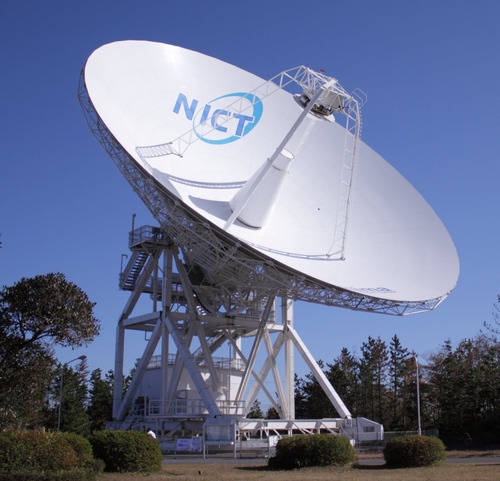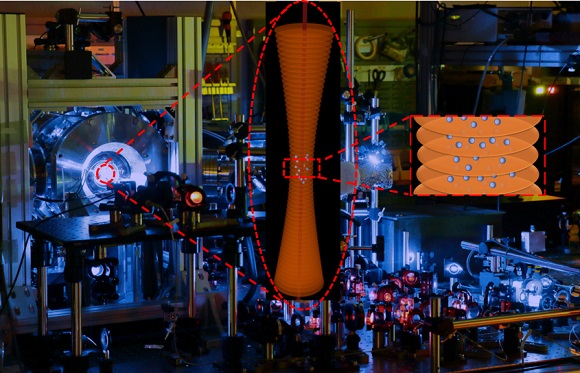Optical Lattice Clock
The current definition of the second as the SI system's unit of time is based on a transition of the cesium atom that is excited by microwave radiation. In recent years, atomic clocks based on transitions in the optical regime have surpassed the performance of clocks based on this microwave transition by more than an order of magnitude. A redefinition of the SI second is considered to make use of such optical clocks.

We are conducting research and development on the optical lattice clock, which was first proposed and demonstrated by Professor Katori of the University of Tokyo and is one of the main types of optical clock. It traps laser-cooled atoms in a standing wave of light (the optical lattice). A large number of trapped atoms can be probed simultaneously by a laser to quickly find the center of an atomic resonance, which provides an accurate, universal reference frequency.
In October 2006, the 698 nm transition in the strontium isotope 87Sr was officially adopted as a "Secondary Representation of the Second" by the Consulting Committee for Time and Frequency (CCTF), instituted by the International Committee for Weights and Measures (CIPM). Starting with the CIPM meeting held in September 2012, the measurements of the strontium optical lattice clock developed at NICT also contributed to the determination of the 87Sr frequency value.

To be accepted as a standard, and maybe even a new definition of the SI second, it is necessary to demonstrate that the same measurement results are obtained everywhere. To verify this, researchers of the Space-Time Standards Laboratory collaborate to implement remote comparisons using a number of different technologies. We have conducted fiber-linked frequency comparisons with the University of Tokyo, as well as satellite-based comparisons with Physikalisch-Technische Bundesanstalt PTB (the German National Metrology Institute), and the Korea Research Institute of Standards and Science KRISS (the Korean National Metrology Institute), with unprecedented accuracy. In 2020 , we demonstrated the use of very long baseline interferometry (VLBI) to compare our strontium clock to an ytterbium optical lattice clock operated by the Italian Institute for Research and Metrology INRIM. In this way, we have confirmed agreement of optical clocks between continents, and not only within Japan.
, we demonstrated the use of very long baseline interferometry (VLBI) to compare our strontium clock to an ytterbium optical lattice clock operated by the Italian Institute for Research and Metrology INRIM. In this way, we have confirmed agreement of optical clocks between continents, and not only within Japan.
In 2016 we were the first to realize a continuous time scale signal based on an optical clock. By using a reliable hydrogen maser frequency reference and steering its output frequency based on the measurements of the optical lattice clock, we were able to generate a highly accurate time signal over a test period of five months. The scale interval of this time signal, the rate of its 1-second "ticks", was shown to be closer to the definition of the SI seconds than that of Coordinated Universal Time (UTC). The generation of this time scale was started again in 2021
we were the first to realize a continuous time scale signal based on an optical clock. By using a reliable hydrogen maser frequency reference and steering its output frequency based on the measurements of the optical lattice clock, we were able to generate a highly accurate time signal over a test period of five months. The scale interval of this time signal, the rate of its 1-second "ticks", was shown to be closer to the definition of the SI seconds than that of Coordinated Universal Time (UTC). The generation of this time scale was started again in 2021 , and it now contributes to the stability of Japan Standard Time to keep it accurate and avoid a dependency on the continuous, undisturbed links to other national and international time scales.
, and it now contributes to the stability of Japan Standard Time to keep it accurate and avoid a dependency on the continuous, undisturbed links to other national and international time scales.
In November 2018 ,
our optical lattice clock was recognized as a Secondary Frequency Standard under the name of NICT-Sr1. It is the second optical frequency standard recognized in this way, following the strontium optical lattice clock of the Paris Observatory in France. From December of the same year, NICT-Sr1 began contributing on-time data to the calibration of the International Atomic Time TAI that forms the basis of UTC and the national time scales derived from it.
,
our optical lattice clock was recognized as a Secondary Frequency Standard under the name of NICT-Sr1. It is the second optical frequency standard recognized in this way, following the strontium optical lattice clock of the Paris Observatory in France. From December of the same year, NICT-Sr1 began contributing on-time data to the calibration of the International Atomic Time TAI that forms the basis of UTC and the national time scales derived from it.

References
1)
H. Hachisu, N. Nemitz and H. Ito,
Standard Time ticks by the light of an Optical Lattice Clock,
NICT News 494 4 (2022)
(2022)
2)
N. Nemitz, T. Gotoh, F. Nakagawa, H. Ito, Y. Hanado, T. Ido and H. Hachisu,
Absolute frequency of 87Sr at 1.8×10−16 uncertainty by reference to remote primary frequency standards,
Metrologia 58 025006 (2021)
(2021)
3)
M. Pizzocaro, M. Sekido, K. Takefuji H. Ujihara, H. Hachisu, N. Nemitz, M. Tsutsumi, T. Kondo, E. Kawai, R. Ichikawa, K. Namba, Y. Okamoto, R. Takahashi, J. Komuro, C. Clivati, Filippo Bregolin, P. Barbieri, A. Mura, E. Cantoni, G. Cerretto, F. Levi, G. Maccaferri, M. Roma, C. Bortolotti, M. Negusini, R. Ricci, G. Zacchiroli, J. Roda, J. Leute, G. Petit, F. Perini, D. Calonico and T. Ido,
Intercontinental comparison of optical atomic clocks through very long baseline interferometry,
Nature Physics 17, 223 (2021)
(2021)
4)
N. Ohtsubo, Y. Li, N. Nemitz, H. Hachisu, K. Matsubara, T. Ido, and K. Hayasaka,
Frequency ratio of an 115In+ ion clock and a 87Sr optical lattice clock,
Opt. Lett. 45, 5950-5953 (2020)
(2020)
5)
H. Hachisu, F. Nakagawa, Y. Hanado and T. Ido,
Months-long real-time generation of a time scale based on an optical clock,
Sci. Rep. 8 4243 (2018)
(2018)
6)
M. Fujieda, SH. Yang, T. Gotoh, SW. Hwang, H. Hachisu, H. Kim, YK. Lee, R. Tabuchi, T. Ido, WK. Lee, MS. Heo, CY. Park, DH. Yu and G.Petit,
Advanced Satellite-Based Frequency Transfer at the 10-16 Level,
IEEE Trans. Ultrason. Ferroelectr., Freq. Control 65 973 (2018)
(2018)
7)
H. Hachisu, G. Petit, F. Nakagawa, Y. Hanado and T.Ido,
SI-traceable measurement of an optical frequency at the low 10−16 level without a local primary standard
Opt. Express 25, 8511 (2017)
(2017)
8)
H. Hachisu, G. Petit and T. Ido,
Absolute frequency measurement with uncertainty below 1×10-15 using International Atomic Time,
Appl. Phys. B 123, 34 (2017)
(2017)
9)
H. Hachisu and T.Ido,
Intermittent optical frequency measurements to reduce the dead time uncertainty of frequency link,
Jpn. J. Appl. Phys. 54, 112401 (2015)
(2015)
10)
T. Ido,
光格子時計の遠隔地間直接比較 (Direct comparison between distant optical lattice clocks),
応用物理学会誌 84巻 第3号 (2015)
(2015)
11)
H. Hachisu, M. Fujieda, S. Nagano, T. Gotoh, A. Nogami, T. Ido, S. Falke, N. Huntemann, C. Grebing, B. Lipphardt, C. Lisdat and D. Piester,
Direct comparison of optical lattice clocks with an intercontinental baseline of 9000km,
Opt. Lett. 39 4072 (2014)
(2014)
12)
T. Ido and M. Fujieda,
時刻・周波数標準の遠距離比較・伝送技術の現状と将来 (Status and future of long-distance comparisons and transmission technology for time and frequency standards),
日本物理学会誌 68巻第4号 (2013)
(2013)
13)
A. Yamaguchi, N. Shiga, S. Nagano, Y. Li, H. Ishijima, H. Hachisu, M. Kumagai and T. Ido,
Stability transfer between two clock lasers operating at different wavelengths for absolute frequency measurement of clocks transition in 87Sr,
Appl. Phys. Express 5, 022701 (2012)
(2012)
14)
A. Yamaguchi, M. Fujieda, M. Kumagai, H. Hachisu, S. Nagano, Y. Li, T. Ido, T. Takano, M. Takamoto and H.Katori,
Direct Comparison of Distant Optical Lattice Clocks at the 10-16 Uncertainty,
Appl. Phys. Express 4 082203 (2011)
(2011)

